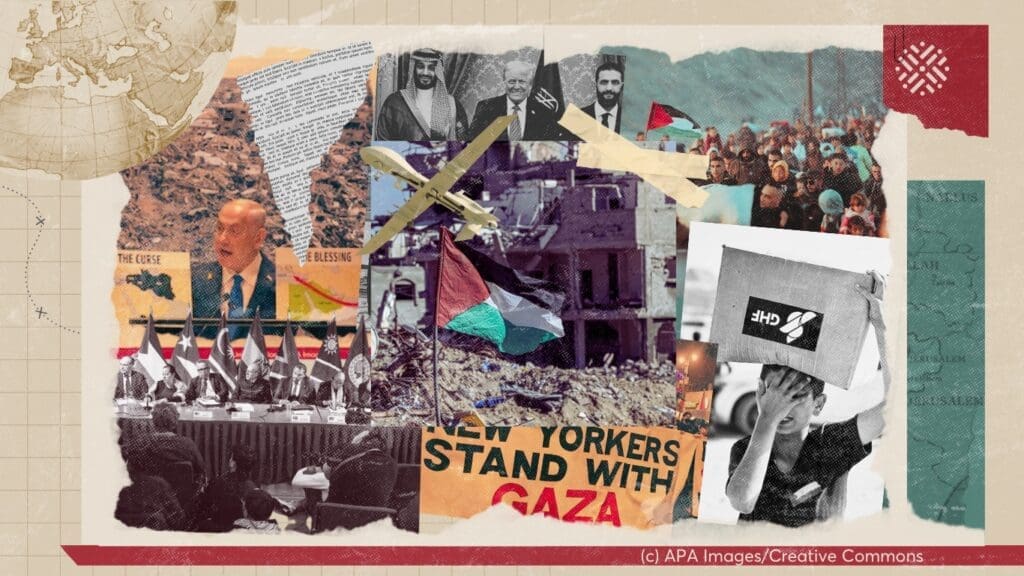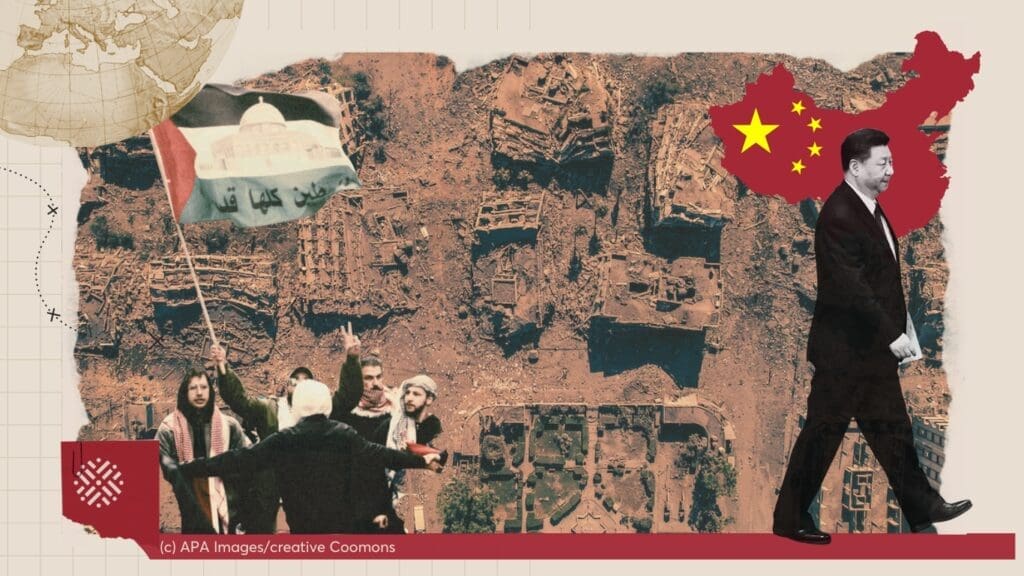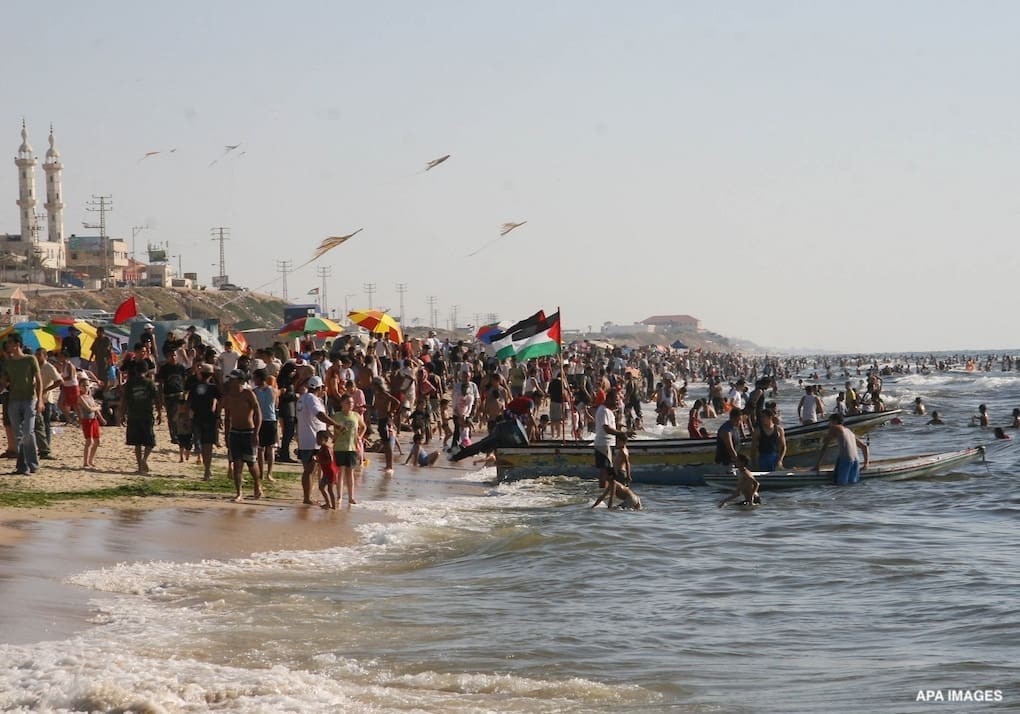- Topics
-
Topics
See our analysis on civil society and how it shapes culture, politics, and policies
Read our insights on the shifting political landscape and what it means for Palestine
Learn more about the policies and practices shaping the Palestinian economy
Strengthen your understanding of the unique conditions for Palestinian refugees across the Middle East
-
- Analysis
-
Analysis
In-depth analysis on existing or potential policies that impact possibilities for Palestinian liberation.
Insights and perspectives on social, political, and economic questions related to Palestine and Palestinians globally.
Concise analysis into a specific policy, its background and implications.
Commentary that brings together insights from multiple analysts.
Compilations of past Al-Shabaka works surrounding a specific theme.
Longer-form, ad hoc projects that seek to confront research questions outside the scope of our regular analysis.
A policy-driven research initiative by Al-Shabaka: The Palestinian Policy Network.
Our monthly webinar series that brings together Palestinian experts.
Featured
For two years, Israel has inflicted mass starvation, staggering death tolls, and relentless destruction on Gaza and its inhabitants. International efforts to recognize Israeli war crimes and halt the eradication of the Palestinian people continue to lag and fall short. On September 16, 2025, the UN Commission of Inquiry confirmed what Palestinians have identified since the outset: Israel is committing genocide. On September 29, US President Donald Trump unveiled a proposal that promises a ceasefire but subordinates Palestinians in Gaza to external governance, denies them self-determination, and entrenches Israeli control over the land. Framed as a peace initiative, the plan is in fact an attempt by the US to shield the Israeli regime from accountability, exemplifying Western complicity in the colonization of Palestine and the extermination of its people. In this context, Hamas’s agreement to release all Israeli captives signals its commitment to ending the ongoing violence, while simultaneously shifting the onus onto the Israeli regime and the Trump administration to clarify and operationalize their commitments to the ceasefire process. This Focus On gathers Al-Shabaka’s analyses from the past year, offering urgent context to understand the genocide and its regional impact. It traces the Israeli regime’s expansionist campaign across Gaza, the West Bank, and the wider region, exposing Western complicity not only in enabling its crimes but also in protecting it from justice. At the same time, it highlights initiatives that resist Israeli impunity while advancing accountability and genuine liberation. Al-Shabaka: The Palestinian Policy Network· Oct 7, 2025This policy memo shows how China’s “biased impartiality,” which privileges the Israeli regime, drives its strategic distancing from the genocide in Gaza. This position is not simply the result of US dominance over Israel-related affairs but a calculated decision to protect China’s long-term interests. By calling for Palestinian unity without exerting pressure on the Israeli government, Beijing shields its ties with the Zionist state under the guise of restraint. In addition, it deflects responsibility for stopping the genocide onto the UN Security Council, casting ceasefire, humanitarian access, and prisoner release as obligations for others in order to absolve itself of direct accountability.
Al-Shabaka: The Palestinian Policy Network· Oct 7, 2025This policy memo shows how China’s “biased impartiality,” which privileges the Israeli regime, drives its strategic distancing from the genocide in Gaza. This position is not simply the result of US dominance over Israel-related affairs but a calculated decision to protect China’s long-term interests. By calling for Palestinian unity without exerting pressure on the Israeli government, Beijing shields its ties with the Zionist state under the guise of restraint. In addition, it deflects responsibility for stopping the genocide onto the UN Security Council, casting ceasefire, humanitarian access, and prisoner release as obligations for others in order to absolve itself of direct accountability. Razan Shawamreh· Sep 16, 2025The erasure of Indigenous populations lies at the core of settler-colonial narratives. These narratives aim to deny existing geographies, communities, and histories to justify the displacement and replacement of one people by another. The Zionist project is no exception. Among Zionism’s founding myths is the claim that it “made the desert bloom” and that Tel Aviv, its crown jewel, arose from barren sand dunes—an uninhabitable void transformed by pioneering settlers. This framing obscures the fact that the colonial regime initially built Tel Aviv on the outskirts of Yaffa (Jaffa), a thriving Palestinian city with a rich cultural life and a booming orange trade. The “dunes” description projects emptiness and conceals the vibrant agricultural and social life that flourished in the area. By casting the land as uninhabitable until redeemed by settlers, this narrative helped justify dispossession and colonial expansion. This process intensified after 1948, when Tel Aviv absorbed the lands of ethnically cleansed Palestinian villages, including al-Sumayil, Salame, Shaykh Muwannis, and Abu Kabir, and ultimately extended into the city of Yaffa. This same settler-colonial discourse drives the ongoing genocidal war on Gaza, where destruction is reframed through the narrative of “uninhabitability.” Gaza is increasingly depicted as a lifeless ruin—a framing that is far from neutral. This commentary contends that “uninhabitable” is a politically charged term that masks culpability, reproduces colonial erasure, and shapes policy and public perception in ways that profoundly affect Palestinian lives and futures. It examines the origins, function, and implications of this discourse within the logic of settler colonialism, calling for a radical shift in language from narratives that obscure violence to those affirming Palestinian presence, history, and sovereignty.
Razan Shawamreh· Sep 16, 2025The erasure of Indigenous populations lies at the core of settler-colonial narratives. These narratives aim to deny existing geographies, communities, and histories to justify the displacement and replacement of one people by another. The Zionist project is no exception. Among Zionism’s founding myths is the claim that it “made the desert bloom” and that Tel Aviv, its crown jewel, arose from barren sand dunes—an uninhabitable void transformed by pioneering settlers. This framing obscures the fact that the colonial regime initially built Tel Aviv on the outskirts of Yaffa (Jaffa), a thriving Palestinian city with a rich cultural life and a booming orange trade. The “dunes” description projects emptiness and conceals the vibrant agricultural and social life that flourished in the area. By casting the land as uninhabitable until redeemed by settlers, this narrative helped justify dispossession and colonial expansion. This process intensified after 1948, when Tel Aviv absorbed the lands of ethnically cleansed Palestinian villages, including al-Sumayil, Salame, Shaykh Muwannis, and Abu Kabir, and ultimately extended into the city of Yaffa. This same settler-colonial discourse drives the ongoing genocidal war on Gaza, where destruction is reframed through the narrative of “uninhabitability.” Gaza is increasingly depicted as a lifeless ruin—a framing that is far from neutral. This commentary contends that “uninhabitable” is a politically charged term that masks culpability, reproduces colonial erasure, and shapes policy and public perception in ways that profoundly affect Palestinian lives and futures. It examines the origins, function, and implications of this discourse within the logic of settler colonialism, calling for a radical shift in language from narratives that obscure violence to those affirming Palestinian presence, history, and sovereignty. Abdalrahman Kittana· Aug 27, 2025
Abdalrahman Kittana· Aug 27, 2025
-
- Resources
- Media & Outreach
- The Network




What’s Really Going On at Rafah?
When it comes to understanding the complicated realities of the Gaza Strip, the Rafah Crossing ranks among the greatest sources of confusion: Many people know it is the main gateway in and out of the blockaded Palestinian territory, and that it is frequently closed. But other details are fuzzy. Many are likely unaware that even when the crossing is supposedly “open”, it is still closed to large segments of the population – both the Palestinian residents of Gaza and others.
The government of the newly elected Egyptian President Mohamed Mursi and Hamas leaders were scheduled to meet mid-September to discuss border security and easing of passage through the Rafah Crossing, according to press reports. The outcome remains to be seen, but so far successive Egyptian governments have adopted the Israeli principles governing the Crossing, even though Israel itself no longer manages it. Simply put, those principles are that, only Gaza Palestinians listed in the Israeli-controlled population registry are permitted to use the crossing. Visitors and non-resident Palestinians – even Palestinians from the West Bank – are still forbidden from entering Gaza, and this includes the spouses of resident Palestinians. Moreover, most young males face great difficulty in passing in or out and are often denied permission outright by Egyptian authorities.
Last month, the Crossing made the headlines again after a series of attacks by masked gunmen on military checkpoints in the Sinai. The Egyptian government closed Rafah indefinitely, much to the dismay of the Gaza Palestinians, who saw no reason for the closure and had no hand in the attacks. The Egyptian move brought back chilling reminders of the policies of years past carried out by both Israel and the government of the deposed president Hosni Mubarak, when the crossing was explicitly closed (according to leaked policy documents at the time) as a punitive measure, a form of collective punishment on the civilian residents of Gaza.
The Mursi government eventually reversed its decision, after having stranded thousands of Palestinians on either side of the border – but it remains an open question how much influence Mursi wields regarding the border crossing, which is controlled by the Egyptian border patrol.
There was a time where Palestinian residents of Gaza could enter the Occupied Palestinian Territories (OPT) through the border crossing from Jordan, and travel to Gaza through the Erez Crossing from Israel. This changed in the late 1990s, and Israel restricted Palestinian entry into Gaza to the Rafah Crossing except for limited and pre-approved cases. Israel manned the crossing with brutality and unpredictability, using it to screen potential informants, to deny entry to “wanted” Palestinians, and to pressure and punish the Palestinian population as a whole by closing the Crossing arbitrarily and abruptly.
In 2005, several months after Israel’s disengagement from Gaza, the United States brokered a complicated deal that would allow for a gradual transition of power over the Rafah Crossing to the Palestinian Authority (a familiar refrain!). The deal required that passenger lists be pre-approved by Israel and for European monitors, known as the European Union Border Assistance Mission to Rafah, and Israeli video surveillance to act as proxies for the Israeli army, who ultimately retained control over the crossing.
The Agreement on Movement and Access, or AMA, as it came to be known, was signed in late November 2005 after months of closure, and was supposed to facilitate the movement of Palestinian people and goods in and out of Gaza. It also promised Palestinian control over the Rafah Crossing into Egypt by November of 2006. At the time, the Agreement was hailed by U.S. Secretary of State Condoleezza Rice as a breakthrough that would “give the Palestinian people freedom to move, to trade, to live ordinary lives.” However, according to a report released by the United Nations Office for the Coordination of Humanitarian Affairs a year after the agreement was signed, Palestinians became worse off both in terms of their freedom of movement and overall economic situation.
All of Gaza’s border crossings, including the Rafah Crossing continued to be controlled by Israel, and movement between Gaza and the West Bank became virtually impossible. In addition, European monitors were only allowed to enter the crossing if Israeli authorized it, and were obligated to leave once so ordered, so there were frequent delays and closures. Indeed, the monitors would flee at the slightest sign of trouble (a backlog of frustrated passengers, striking workers, etc.).
Following Hamas’s election victory in 2006 and 2007 counter-coup, European monitors fled once and for all, and the Mubarak regime, colluding with Israel, sealed Gaza hermetically, and shut down the Rafah Crossing indefinitely. Mubarak’s Egypt “conditioned” its re-opening of the crossing on a Fateh-Hamas reconciliation agreement, the release of captured Israeli soldier Gilad Shalit, and a return of the European monitors under the much-maligned border agreement.
But the Palestinians who lived there did not want their hand forced. Nor did they want a return to the AMA. No matter how bad the present was, it would be a step in the wrong direction, taking away their freedoms in the long term for some short-term relief.
Finally, in June of 2010, shortly after the deadly Israeli attack on the “Free Gaza” flotilla, and in a bid to appease rising dissatisfaction with his Gaza politics, Mubarak announced that the crossing would be re-opened. However, it was shut down again at the start of the Egyptian revolution in 2011. After Mubarak was deposed, it was announced that the border would be re-opened on a regular basis, and Egypt’s then foreign minister, Nabil el-Araby, opened discussions with Hamas aimed at easing the travel restrictions and improving relations between the two sides. Human rights advocates rejoiced, taking this to mean the effective end of the siege on Gaza – or at least of one aspect of the siege.
Yet how truly “open” has the crossing been? It’s true that the crossing has been open on a more regular basis and to a greater number of Gaza residents. However many of the traditional restrictions remain in place: males 18-40 still require pre-approval, find it difficult to obtain entry visas to Egypt, or are banned altogether. To put things in perspective, they constitute about a quarter of Gaza’s population.
Moreover, it should be noted here that in order to get to the Rafah Crossing to start with, Palestinians need first to enter Egypt. This of course requires an Egyptian visa, which is often denied, especially to young people or those without a foreign residency of some sort. A cousin of mine – a brilliant young scholarship student from Gaza currently studying in Mississippi – has been trying for three years, to no avail, to obtain an Egyptian visa in order to go visit his family in Gaza and return home. He is one of thousands in a similar situation. As recently as this month, my parents, both in their late 60s, were denied Egyptian entry visas en route back to Gaza from a U.S. visit. All of them hold Gaza residency cards.
Nevertheless, as anyone who has suffered long hours (or days or weeks or months) in the punishing heat or bone-numbing cold of this little corner of the world awaiting entry or exit can attest, even this limited opening of the crossing was news to be celebrated.
But with access still limited to certain segments of society, and, critically, to the Palestinians in Israeli-controlled population registry, the so-called re-opening of Rafah Crossing is simply a return to status quo of years past: only Palestinians carrying an Israeli-approved Gaza ID card can use Rafah Crossing.
In other words, Palestinians from the West Bank or East Jerusalem, Palestinians in refugee camps outside the OPT, 1948 Palestinian citizens of Israel, or Palestinians living in diaspora, are all still not allowed passage to Gaza through Rafah. This includes Palestinian families, such as my own, where one spouse possesses an ID but the other does not. It also includes internally displaced Palestinians who live in Gaza but whose IDs were never approved by Israeli authorities and who are not allowed to exit. These cases number in the tens of thousands.
Additionally, as the rights organization GISHA reminds us, the crossing does not lead to the West Bank, nor does it allow for the passage of goods, which are restricted to the Israeli-controlled crossings and subject to prohibitions on construction materials and export. In a nutshell, Rafah can never be the sole crossing for Palestinians residents of Gaza. Gaza remains under tight maritime and aerial siege, and continues to be closed off to the Palestinians’ cultural, economic, and academic capitals in the rest of the OPT. Israel has a legal obligation to permit passage of people and goods between Gaza and the West Bank, which are internationally recognized as a single territorial unit.
As a first step, though it is not nearly enough, Palestinians desire sovereignty over their side of the Rafah Crossing – the ability to determine who can use it and when. Critics say this might be perceived as an indication that Gaza is “free” and therefore play into Israel’s grand plan of separating Gaza from the West Bank. But the crossing is no more an indicator of Palestinian sovereignty than a local government is and should not be taken to absolve Israel from its obligations as Occupier. That Gaza is still under occupation is affirmed by Israel’s continued control over such markers of sovereignty as air space, borders, maritime access, population registry, and taxes.
The Rafah Crossing remains the sole passage in and out of Gaza for all its residents. At the present time, its operation and usage remains under the control of Egypt and managed by Israeli guidelines. And as last month’s incident demonstrates, the situation remains unstable and the Crossing itself unreliable. Unlike airports or traditional border crossings, it is still liable to be completely shut down at a moment’s notice, stranding both Palestinians, and their economy. So far, Egyptian policies on the crossing have not departed from those of years past. It remains to be seen whether the Mursi government’s meetings with Hamas can or will bring change.
Laila el-Haddad
Latest Analysis
Two Years Since October 7: Gaza Genocide and Geopolitics
China and the Gaza Genocide: A Strategic Distance
Gaza Uninhabitable: Challenging Colonial Frames of Erasure
We’re building a network for liberation.
As the only global Palestinian think tank, we’re working hard to respond to rapid developments affecting Palestinians, while remaining committed to shedding light on issues that may otherwise be overlooked.